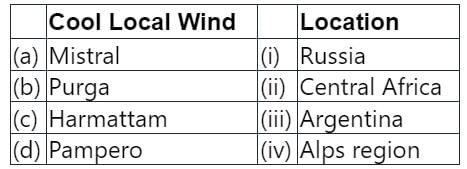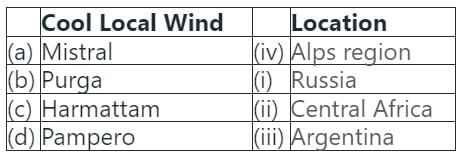Test: Physical Geography- 1 - UPSC MCQ
25 Questions MCQ Test - Test: Physical Geography- 1
Consider the following statements:
- The velocity of seismic waves is higher in denser materials.
- P-waves can move through both solids and liquids, while S-waves can only move through solids.
- Love waves move in an elliptical motion.
How many of the statements given above are correct?
Consider the following statements:
- P-waves are also known as compressional waves.
- S-waves cause the ground to move in a pushing and pulling motion.
- Surface waves arrive before body waves.
How many of the statements given above are correct?
Consider the following statements:
- The shadow zone of S-waves is created because they cannot travel through the Earth's liquid outer core.
- The Earth's outer core was deduced to be solid due to the behavior of S-waves.
- P-waves can be refracted by the liquid outer core, creating a shadow zone.
How many of the statements given above are correct?
Consider the following statements:
- Oceanic crust is primarily composed of basalt.
- Continental crust is primarily composed of granite.
- Oceanic crust is thicker than continental crust.
How many of the statements given above are correct?
Consider the following statements:
- The Earth's lithosphere includes both the crust and the upper mantle.
- The asthenosphere is a rigid layer located beneath the lithosphere.
- The movement of tectonic plates is driven by convection currents in the mantle.
How many of the statements given above are correct?
Consider the following statements:
Statement-I: The temperature at the junction of the mantle and outer core is between 2900-3700°C.
Statement-II: The temperature at the junction of the mantle and outer core is primarily a result of internal heat sources, the geothermal gradient, and the high pressure at such great depths.
Which one of the following is correct in respect of the above statements?
Consider the following statements:
Statement-I: S-waves cannot travel through the Earth's liquid outer core. Statement-II: This property of S-waves led to the conclusion that the Earth's outer core is liquid.
Which one of the following is correct in respect of the above statements?
Consider the following statements:
Statement-I: Continental drift theory was proposed by Alfred Wegener.
Statement-II: The theory suggests that continents move due to forces generated by Earth’s rotation.
Which one of the following is correct in respect of the above statements?
Consider the following statements:
Statement-I: The movement of the Earth's tectonic plates can cause earthquakes.
Statement-II: Tectonic plates move because of convective currents in the mantle.
Which one of the following is correct in respect of the above statements?
Consider the following statements:
Statement-I: Basalt is the primary rock type found in oceanic crust.
Statement-II: Basalt forms from slow cooling of magma at the surface.
Which one of the following is correct in respect of the above statements?
Select the correct option from the given alternatives.
Statement (a) - The shape of Indian Ocean is S
Statement (b) - The S shape of Indian Ocean provides an ideal location for natural harbours
Which one of the following is the dominant element of the Earth's crust?
In which one of the following cities the mountains of sand called “Sand Dunes” are found?
The Andaman islands were hit by a tsunami in the year
Piecing together the puzzle of geologic time to create and analyze historical maps of the Earth is known as
Select the correct statements about Abu Dhabi:
A. It is located in a desert area.
B. Water is costlier than petrol in Abu Dhabi.
C. Arabic is the local language here.
D. Money used in Abu Dhabi is called Dinar.
Which earthquake measuring scale is based on Earth’s rigidity and the amount and area of slip on the fault?
The direction of wind around a low pressure in northern hemisphere is:
Consider the following statements about Jet Stream circulations choose the correct ones:
1. Jet stream is a current of fast moving air found in the upper levels of the atmosphere somewhere between 10-15 km above the earth’s surface
2. The position of jet stream denotes the location of the strongest surface temperature contrast.
3. Winds of jet stream are stronger in summer than winter.
4. Jet streams generally blow from west to east.
Choose the correct answer
Excluding the moon, the celestial object that generally appears bright in the sky is





















